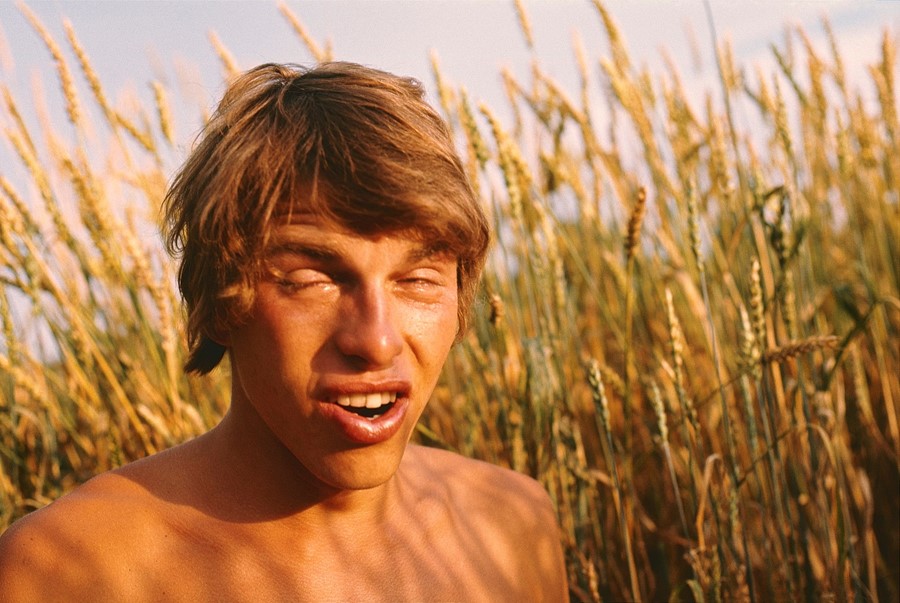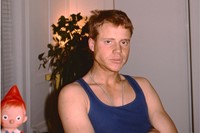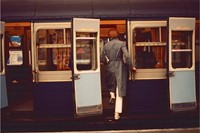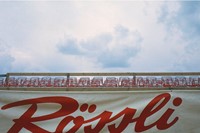As the subversive Swiss artist is celebrated with an ambitious survey at New York’s Swiss Institute, he speaks to AnOther about resilience and the art world and society’s changing attitudes to gay imagery
A large drawing of a cat’s face opens Walter Pfeiffer’s first career survey in New York, organised by Simon Castets and Daniel Merritt at the Swiss Institute. The turquoise-eyed feline’s curious expression on a wall divider is a fittingly anarchic – yet veiled with light-hearted ease – entry into the multi-hyphenate Swiss artist’s five-decade-long practice, which fills both floors of the East Village institution with innumerable works in the realms of photography, drawing, collage, graphic design and film. In fact, the gritty downtown neighbourhood – which many 1980s icons called home – was Pfeiffer’s stomping ground for a short period of time four decades ago. A year-long stint in New York, however, is only a slice in a mosaic that constitutes the 76-year-old artist’s rollercoaster career.
After starting out in the 1970s with Dada-inspired mixed-media experiments, Pfeiffer made his best-known works; Polaroids of young men with a countercultural edge. In the 80s, he had solo shows at Kunsthause Zurich and Kunsthalle Basel, but, stressed by the homophobic reception of his intimate images of friends and strangers, Pfeiffer later put his lens aside to focus on drawings for a decade as well as teaching and doing commercial graphic design work.
In the early 2000s, his photographic work re-emerged thanks to collective interest in Pfeiffer’s punk-like approach to homoerotic art; many fashion editors began following his work and eventually commissioned him for editorials in French Vogue, Dazed, and i-D. The moment also led the artist to spend more time behind the camera and expand his lens-based oeuvre. Along the way, his repertoire has become the subject of various publications and zines, including Welcome Aboard: Photographs 1980-2000 and a lofty documentation of his half-century work, titled Bildrausch. Drawings 1966 – 2018.
AnOther spoke with Pfeiffer over Zoom about the rewards to be found in resilience, the many lives he has had in and outside the art world, and the tricks of weathering ebbs and flows throughout society’s changing attitudes to gay imagery.
Osman Can Yerebakan: The massive cat drawing on fiberboard bookends your career between starting out with an influence from Dada and ending up with this New York survey. Could you share the work’s history?
Walter Pfeiffer: This image takes me back to decades ago when I was among the first students of Form & Farbe in 1966. Then, after an experimental Dada-style art education, I thought I could do anything, and given pop art also had a big influence on the era and I always had cats around me, I chose to make a folding screen drawing of a cat’s face. I donated the work to my elementary school Neunkirch near my hometown village, Beggingen. They used it on the school’s stairwell for many years, but during renovation, the work ended up in the garbage. They just decided to get rid of it and left it outside. Luckily, my sister saw that the discarded wall divider was being collected by someone on the street who turned out to be the architect Ernst Reich. I got in touch with Ernst and told him that as the work’s rescuer, he deserved to own it. He said he considers himself the guardian, not the owner. Swiss Institute borrowed the work from Ernst for this show.
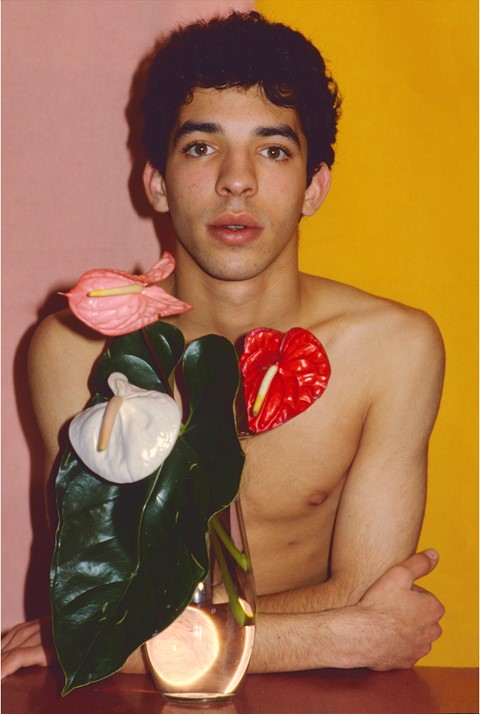
OCY: How was your early lens-based work influenced by an avant-garde education at Form & Farbe?
WP: First of all, it was a difficult school but we had great teachers like the Marcel Duchamp scholar Serge Stauffer who had written many books on him. Other than Duchamp, we were educated on Dada’s other artists who were not as known but were influential. When I started taking pictures of boys in 1971, the only mainstream homoerotic imagery was from the classical era – there was no contemporary photography of male nudes. I had to produce the work all on my own in my own world because I did not want to hear people’s criticism any longer. I also did commercial work, like film posters, and worked at the department store Globus at the time because I was trying things out but also make a living.
OCY: How did commercial work – the idea of promoting an entity through photography – inspire your own lens-based practice? The immediacy in commercial imagery can be similar to the idea of communicating with the viewer in queer photography.
WP: After three years of an apprenticeship in a graphic studio, I was able to take control of the technical aspect of both my commercial work and artistic practice. I could do posters and books by myself without needing outside support which would not come anyway because of my work’s gay content. In order to avoid the neglect, I started the Walter Pfeiffer Company to produce my own work. I had many cats at the time and I considered them the staff at my company. The books I made during the 70s departed from a typical catalogue format and did not have captions or any text, which was, in a way, informed by my schooling and graphic design work.
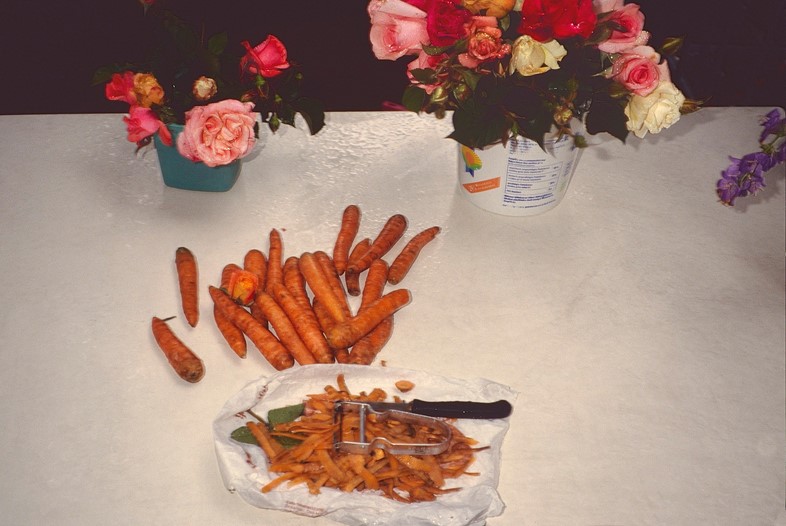
OCY: Your subjects vary from bodies engaging with themselves or each other to everyday objects in mundane moments. How did you weave together this multiplicity to create a diverse visual lexicon?
WP: I always loved still lifes, both in photography as well as painting, when I quit photography for more than ten years around the mid-80s. Even when I was shooting with someone, I made sure to click my camera for things around us. With my subjects, I always tried to play naive to give them the confidence to be themselves and feel free – maybe engage with some small talk and make them feel comfortable in front of the camera. I liked capturing them while they showered, ate and just moved on with their lives. I liked the idea that they were not posing and I could just hit the shutter.
The fact that my photographs were not intended for an exhibition, book or magazine gave [me] the freedom to do whatever we would like. Nobody wanted to publish my content anyway and they mainly stayed as slideshows for a long time. Labs would not develop my images because I was not considered professional. My idea was to take as many images as possible with my analogue camera and see what comes out of it.
OCY: How was your relationship with your subjects? Did you build friendships or relationships or did you always maintain a step of formality? Was queerness a bonding element between you and your posers against the homophobia outside?
WP: I didn’t choose my models with an intention to take them home or even whether they were gay or straight. I never cast from the streets but rather my friendship circles always introduced me to new people. I would ask a friend to ask his friend to ask another guy I was interested in photographing. They mostly said yes. I didn’t have a professional studio which might have helped them feel more comfortable. In the summer months, I shot outside, and we went inside when the winter came. Some models stayed and others only posed for once. With some of them, I’ve had lifelong friendships – a friend who was once one of my models even helped me get some negatives for this show. My models always inspired me to keep going while my mentors were critical about my work due to its content which encouraged me to push in different ways. Some of my models have children and grandchildren now, and they love seeing their dads’ pictures from when they were 18.
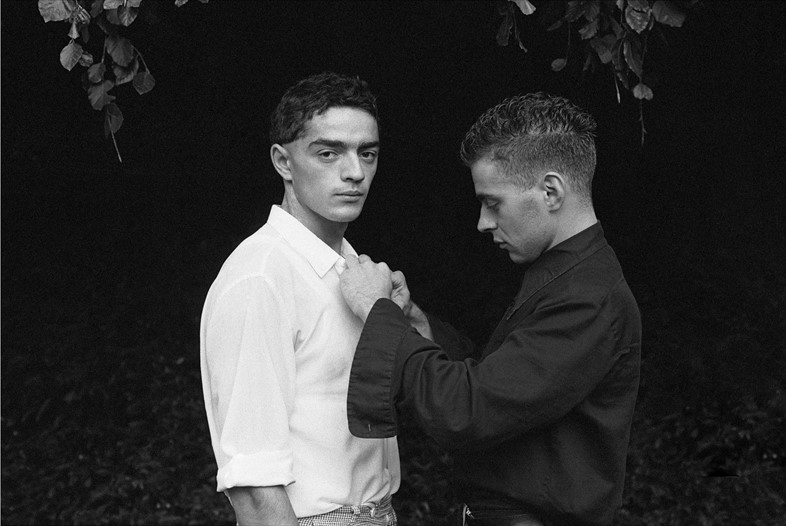
OCY: Could you talk about your time in New York? This was also a critical time for queer art in the city right on the cusp of the Aids pandemic.
WP: I came to New York in 1980 on a government grant and rented an apartment on West Broadway in a building where Leo Castelli had his gallery. This is when planes were very expensive but a bank had sponsored my flight. When people from the bank wanted to visit my studio, I had to hide the gay content and show them the kind of art they wanted to see. I played the typical role of the artist. I had Xerox prints of a book I was trying to make but I put them aside and showed a few paintings I had made for them.
When I moved to New York, I wanted to change everything, including my hair colour. I bought a hair colouring product from Bloomingdale’s to dye my hair light blond. The colouring didn’t turn out the way I had imagined, and while I was desperate to fix my hair, a friend came over with his friend. This man was a hairdresser and eventually became a model of mine. Then, I learned that he was one of Peter Hujar’s favourite models as well. Years later, I came back to New York for a solo exhibition at the now-closed bookstore Scalo in 2002 which received a review on Artforum by Bob Nickas.
Walter Pfeiffer is on show at Swiss Institute in New York until August 28.
